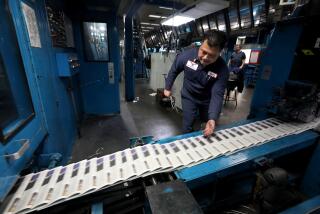Extra! Extra! Read All About It--on the Net
- Share via
How does a newspaper or a magazine “scoop” itself?
By putting a story online before it appears in the next printed issue.
In recent weeks, the Dallas Morning News, Playboy and Time have chosen to break big stories on their World Wide Web sites to ensure the exclusivity of the pieces during the period before the next issues went to press. By taking advantage of interactive media’s ability to get out news more quickly, the publications surmounted the competitive disadvantage imposed by print deadlines while showcasing their own ability to act like around-the-clock news organizations in a CNN world.
In what is widely considered one of the bolder steps forward among newspapers, the Dallas Morning News, on the afternoon of Feb. 28, reported on its Web site (https://www.dallasnews.com) that Timothy McVeigh had admitted his guilt in the Oklahoma City bombing to his attorneys. The paper’s story, which appeared in print the next day, was echoed by other broadcast and print media around the country.
“It didn’t make sense to hold the story for 14 hours for distribution by truck the next day,” said Dale Peskin, the paper’s assistant managing editor for new media. “There was a concern that the story would leak before the next day’s paper, once we finished getting comment from federal court officials and others, who then knew about our story.”
The following Friday morning--three days before the next issue of Time was to go on sale--Time Daily (found via https://www.pathfinder.com) endowed weekend news broadcasts with a hot story when the site reported that federal authorities suspected the same bombers may have triggered the blasts in Atlanta at Olympic Park, an abortion clinic and a gay nightclub. Time Managing Editor Walter Isaacson, who previously established Time Inc.’s new-media efforts, decided to put Elaine Shannon’s exclusive online after the reporter sensed from questions being asked of U.S. Atty. Gen. Janet Reno that other news organizations were closing in on the same story.
“We’ve broken a lot of stories online,” said Janice Castro, the editor of Time Online (of which Time Daily is a part). “After the [1995] bombing in Oklahoma City, Time put five or six reporters on the story, so that over the next three days we broke several exclusives on developments as they happened.”
Playboy last week put an original piece of reporting on its Web site (https://www.playboy.com) for the first time, corroborating the Dallas Morning News’ story on McVeigh. The Playboy account was written by freelance journalist Ben Fenwick, who said his “lawfully obtained documents” pointing to McVeigh’s admission of guilt may be different from those cited by the Dallas paper, but corroborate basic facts in the earlier story.
Fenwick’s profile of McVeigh is scheduled to run in Playboy’s June issue, which won’t be available until May 6. “We decided to get out the story the quickest way we could,” said Elizabeth Norris, Playboy’s director of public relations.
More than 500 of the country’s 1,600 daily newspapers maintain an online presence, according to Randy Bennett, vice president for new media with the Newspaper Assn. of America. “A lot of them are updating their sites regularly, not waiting for the newspaper to appear,” he said.
The Los Angeles Times puts its critics’ movie reviews online (at http://vinapk.com) the night before they appear in the paper. But the Times’ Web site mission--”to be a comprehensive source of information about Southern California on the Internet”--does not necessarily herald an effort to update the site on a running basis with more than the news wires. “When you strip it all away, it comes down to habit, and I don’t think people have the habit yet of turning to the Web for breaking news,” said Deputy Managing Editor Terry Schwadron, who leads The Times’ editorial efforts online.
Although industry observers question whether the release of enterprise news online spurs or undercuts newsstand sales of the printed issue that follows, it’s widely agreed that an online presence draws valuable attention to a publication.
Castro, of Time Online, said: “Every measure we have tells us that doing good journalism online is leading people back to the magazine.”
Afterwords: Esquire’s Randall Rothenberg has leapfrogged from senior writer into a new No. 2 position at the magazine--editorial director. Word of the promotion had been circulating for days, prompting speculation that Rothenberg, a book author and magazine veteran who now holds rank over longtime Deputy Editor David Hirshey, is poised to succeed Edward Kosner as editor in chief. Hearst Magazines waited until Tuesday to make an official announcement of Rothenberg’s promotion.
Esquire’s declines in circulation and ad pages are well-known. The move comes as the magazine sets about widening its editorial focus to include more service pieces.
* Paul D. Colford is a columnist for Newsday. His e-mail address is [email protected]. His column is published Thursdays.


